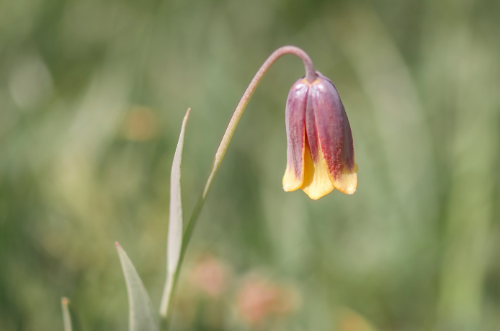The world is a garden adorned with patterned flowers that drip from the brush of the Sublime Beauty. Each flower has its own fragrance, each dances in its own color. Among these flowers, there is one that whispers the name of the All-Powerful in our hearts, encompassing a thousand names and Attributes of the Lord: “Allah, Allah…”
The tulip is a flower that belongs to the Liliaceae family, commonly known as the lily family. It usually has six petals and a wide bell-shaped cup.[1] Its flowers can be single-colored and pastel-toned, or some varieties can have two colors and vibrant tones. Tulips obey the divine command and start blooming with wisdom in the month of April, when the rains of divine mercy are abundant. When the rains cease, they respond to another divine command, shedding their leaves and withering. Therefore, tulips are flowers that herald the arrival of spring.
Nothing is coincidental in the world created by the All-Gracious Builder, and everything is interconnected and intertwined, just like the tulip and the majestic word “Allah.” It is magnificent that the Name “Allah” is hidden within the tulip. When examined as words, it can be seen that the tulip (لاله) carries the letters of the Arabic word for “Allah” (ﷲ). Both words contain an “alif”, two “lam”s, and a “ha”, and according to the Abjad numerals, they correspond to the number 66.[2]
The tulip, which is given special value and carries an important secret, has become one of the most widely used motifs in art from the Ottoman era to the present day. Tulip motifs can be seen everywhere, from mosques, fountains, and bridges to various art forms such as marbling, ceramics, fabrics, carpets, and walls of buildings. The Selimiye Mosque, adorned with 101 different tulip motifs on its tiles, is one of the precious examples of this.
The Selimiye Mosque, the masterpiece of Mimar Sinan (the Architect) and the Ottoman civilization, captivates our aesthetic senses with its elegant single dome and tall minarets reaching for the sky like a pen. Architecturally and aesthetically unparalleled, it was constructed during a period when Turkish-Islamic civilization reached its zenith in the Ottoman Empire. This historic mosque, admired by visitors and art historians, is famous not only for its immense significance but also for the reverse tulip motif engraved on one of the columns supporting the minbar. This reverse tulip motif has made the Selimiye Mosque famous and has a melancholic story behind it.
According to the tale, years after the construction of the Süleymaniye Mosque, Mimar Sinan came from Istanbul to Edirne to build Selimiye, the only large domed mosque of that time. When the construction of this magnificent masterpiece, which would take seven years to complete, began, Mimar Sinan was already 80 years old. His children had grown up, and he even had grandchildren. Among his grandchildren, there was a girl named Fatma, who was the apple of his eye and the joy of his heart. Unable to bear the longing for Fatma during his days spent far away from Istanbul in Edirne, Mimar Sinan wanted to bring her to be with him, even if only for a short time. Traveling from Istanbul to Edirne on horseback in those days was a laborious task. Mimar Sinan sent a message to his children, informing them of the unbearable longing for Fatma and that he was waiting for her in Edirne. Despite the difficulties, Fatma managed to come to her beloved grandfather. Mimar Sinan never let go of his granddaughter Fatma even for a moment; he took her with him to the construction site and returned with her. However, the winter in Edirne was harsh. Eight-year-old Fatma couldn’t withstand the cold of Edirne and fell ill, confined to her bed. The physicians were called in, and every effort was made from all sides to find a cure for her illness. But fate had predetermined Fatma’s demise.
Fatma’s fragile body could not withstand the illness for long, and in Edirne, where she came to see her grandfather, she embarked on the horizon of Paradise. The death of his granddaughter turned Mimar Sinan’s summer into winter. Koca Sinan was unable to recover for days. The smiling architect who enchanted everyone with his genius had gone, replaced by a silent man whose heart reflected his sorrow with a deep sigh. Mimar Sinan had a six-columned tomb built for his beloved Fatma, with a small marble sarcophagus placed on top. He had it inscribed on the forehead of the sarcophagus that it belonged to Fatma’s grandchild and depicted his grief with a reverse tulip, its head bowed.
Separation’s pain has made my tears turn into blood on my yellow face,
Sorrow has turned my yellow face into a tulip garden. (Ali Şîr Nevaî)
The agony of Mimar Sinan, whose tears turned into blood due to the pain of separation, deeply affected his apprentices and stone craftsmen who revolved around him like moths. One of his apprentices couldn’t bear it; secretly, he carved a reverse tulip at the foot of the minbar, which was placed in the center of Selimiye’s interior, and concealed the sorrow of Sinan the Grand Architect and the bittersweet memory of his beloved Fatma within that tulip for centuries.[3]
[3] Talha Uğurluel, “Edirne Selimiye Mosque and Reverse Tulip – Stories from our history”




